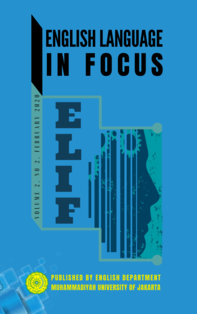Fostering Students’ Speaking Ability through Traditional Talking Stick
DOI:
https://doi.org/10.24853/elif.2.2.71-78Keywords:
The Effectiveness, Speaking ability, Traditional Talking StickAbstract
The research was about the effectiveness of Traditional Talking Stick to foster students’ speaking ability on eight-grade of MTs Salafiyah Syafi’iyah in the 2018/2019 academic years. This study aimed to determine the effectiveness of the Traditional Talking Stick teaching method on students speaking abilities, before and after using the Traditional Talking Stick method. There were 36 students as samples in this study. Researchers used a quasi-experimental using 4-times pre-test and 4-times post-test design. The data of this study was collected from observation and speaking tests (pre-test and post-test). The data analysis was then performed using a T-test (paired simple test) facilitated by SPSS 16.0. The results of this study were (1) the average scores of students’ pre-test on their speaking ability before using Traditional Talking Stick were 28,61 of pretest 1, 30,97 of pre-test 2, 33,92 of pre-test 3, 36,69 of pre-test 4-with all the of unsuccessful criteria. (2) the students’ average scores of speaking ability after being taught using Traditional Talking Stick were 75,6 of post-test 1, 77,86 of post-test 2, 82,28 of post-test 3, 84,89 of post-test 4-with all of the success criteria. (3) The result of the students’ average scores shown that there is a significant effect of the Traditional Talking Stick in students’ speaking ability after-treatment. It is as explained from the gained of obtained pretest 4 and post-test 4 average scores, in which t-count is -75,302 (at df = 35) and t table = 2, 03011, which means that the result of the SPSS calculation has been successful.References
Ananda, E., Sofian, & Salam, U. (2017). Improving Students’ Speaking Performance by Using Talking Stick Method. Jurnal Pendidikan dan Pembelajaran Untan, 6(8), 2–11. Retrieved from http://jurnal.untan.ac.id
Arief, H. (2017). The Effectiveness of Talking Stick Method in Teaching Vocabulary at the Second Grade of MTs Madani Pao-Pao. Undergraduate (S1) thesis, Universitas Islam Negeri Makassar. Retrieved from http://repositori.uin-alauddin.ac.id/7784/
Cornelius-Ukpepi, B. U., Aglazor, G. N., & Odey, C. O. (2016). Cooperative Learning Strategy: Tool for Classroom Management at the Basic Level of Education in Cross River State, Nigeria. In Proceedings of the iSTEAMS Multidisciplinary CrossBorder Conference. University of Professional Studies, Accra Ghana. Retrieved from https://www.researchgate.net/publication/324779885
Dewi, R. S., Kultsum, U., & Armadi, A. (2016). Using Communicative Games in Improving Students’ Speaking Skills. English Language Teaching (ELT), 10(1), 63. https://doi.org/10.5539/elt.v10n1p63
Fitri, M., Sari, W. V., Eliyati, & Aisyah, N. (2016). The Effect of Applying Talking Chips Technique on the Students’ Achievement in Speaking Ability. Proceedings of ISELT FBS Universitas Negeri Padang, 4(2), 62–67. Retrieved from http://ejournal.unp.ac.id/index.php/selt/article/view/6962
Fujioka, K. (1988). The Talking Stick: An American Indian Tradition in the ESL Classroom (TESL/TEFL). The Internet TESL Journal, 4(9). Retrieved from http://iteslj.org/Techniques/Fujioka-TalkingStick.html
Lawota, Y. (2018). Penerapan Teknik Cerita Berantai untuk Meningkatkan Keterampilan Berbicara pada Siswa Kelas IV SD Inpres Nangameting. At-Tadbir : Jurnal Manajemen Pendidikan Islam, 2(2), 39–51. Retrieved from https://doi.org/10.3454/at-tadbir.v2i2.3128
Saraswati, A. A. (2016). Using Talking Stick Method to Improve Students’ Reading Mastery at the Second Grade Students of SMPN 1 PRINGAPUS in the Academic Year of 2016/2017. Undergraduate (S1) thesis, IAIN Salatiga. Retrieved from http://e-repository.perpus.iainsalatiga.ac.id/1513/
Sugiyono. (2009). Statistika untuk Penelitian. Bandung: Alfabeta.
Sugiyono. (2011). Metode Penelitian Pendidikan: Pendekatan Kuantitatif, Kualitatif dan R&D. Bandung : Alfabeta.
Yolanda, D., & Hadi, M. S. (2019). Using Puppet Games in Teaching Speaking for Tenth Graders of Senior High School. English Language in Focus (ELIF), 2(1), 1–8. Retrieved from https://jurnal.umj.ac.id/index.php/ELIF/article/view/4824
Zakiah, Rosnija, E., & Arifin, Z. (2014). Improving Students Speaking Frequency Through Talking Stick. Jurnal Pendidikan Dan Pembelajaran Untan, 3(3), 214711. Retrieved from http://jurnal.untan.ac.id
Zuhriyah, M., Agustina, R. K., & Fajarina, M. (2018). The Influence of Students’ Creativity to Construct Sentences toward Their Speaking Skill. Register Journal, 11(1), 1–18. https://doi.org/10.18326/rgt.v11i1.1-18
Downloads
Published
Issue
Section
License
Authors who publish with this journal agree to the following terms:
- Authors retain copyright and grant the journal right of first publication with the work simultaneously licensed under a Creative Commons Attribution License that allows others to share the work with an acknowledgment of the work's authorship and initial publication in this journal.
- Authors can enter into separate, additional contractual arrangements for the non-exclusive distribution of the journal's published version of the work (e.g., post it to an institutional repository or publish it in a book), with an acknowledgment of its initial publication in this journal.
- Authors are permitted and encouraged to post their work online (e.g., in institutional repositories or on their website) before and during the submission process, as it can lead to productive exchanges, as well as earlier and greater citation of published work (See The Effect of Open Access).


